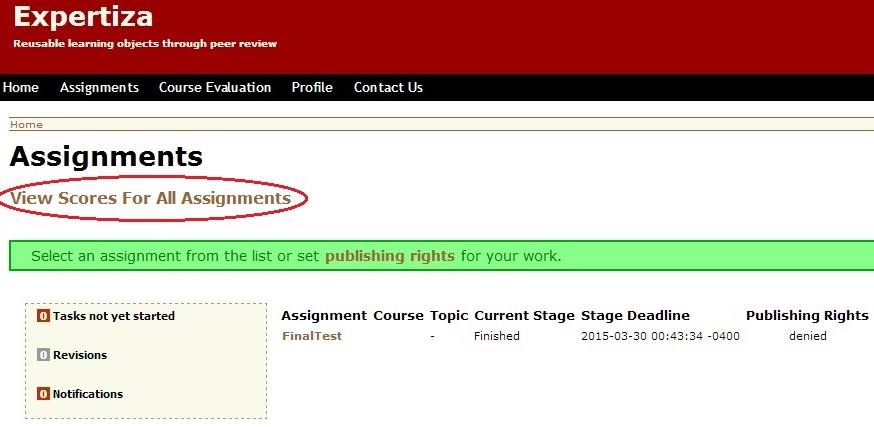CSC/ECE 517 Spring 2014/oss E1404 mnp: Difference between revisions
| Line 20: | Line 20: | ||
== Design and implementation == | == Design and implementation == | ||
=== Objective 1: Get scores of all the assignments for a given user === | === Objective 1: Get scores of all the assignments for a given user === | ||
A new view was required since this view did not exist previously. A new link has been added to the user's homepage. | |||
[[File:View_all_scores_link.jpg]] | |||
We needed to write a method and add a view that computed the scores of a user across all the assignments user has participated in. We added a new method all_scores in the grades_controller.rb. This method executes the following steps: | We needed to write a method and add a view that computed the scores of a user across all the assignments user has participated in. We added a new method all_scores in the grades_controller.rb. This method executes the following steps: | ||
| Line 40: | Line 43: | ||
The score type is a hash that takes any of the three values [avg, max and min] as key the value will be the actual score. | The score type is a hash that takes any of the three values [avg, max and min] as key the value will be the actual score. | ||
Once the hash is created and populated accordingly, this hash is used by the view to display to the user as below: | |||
=== Objective 2: Improve the speed of getting scores for a given assignment === | === Objective 2: Improve the speed of getting scores for a given assignment === | ||
Revision as of 04:58, 30 March 2014
Improvement to View Scores
Introduction
Background
The scores are calculated for multiple views. This code is very slow because:
- Separate db queries are used for each rubric that has been filled out by anyone associated with the assignment; these queries are made sequentially while the HTML page is being written
- HTML for the whole page is generated, largely by controller methods, before anything is displayed.
This code needs to be made faster.
What needs to be done
Classes
models/score.rb controllers/grades_controller.rb
Objectives
- Participant.find(user id).scores # should return a Hash or new object, with a single database query. This method should return the scores of a participant from all the assignments in which the participant has submitted.
- assignment.scores # should return a Hash or new object, with a single database query. This method should return scores of all the participants in an assignment.
- course.scores # should return a Hash. This method should return scores of all the participants enrolled in a course.
Design and implementation
Objective 1: Get scores of all the assignments for a given user
A new view was required since this view did not exist previously. A new link has been added to the user's homepage.

We needed to write a method and add a view that computed the scores of a user across all the assignments user has participated in. We added a new method all_scores in the grades_controller.rb. This method executes the following steps:
- :Executes the below sql query:
SELECT assignments.name, questionnaire_type, avg(score), min(score), max(score) FROM (SELECT r.id as response_id, team_id, tu.user_id as user_id, (SUM(weight*score)*100)/(sum(weight)*max_question_score) as score, parent_id as assignment_id, qs.type as questionnaire_type FROM scores s ,responses r, response_maps rm, questions q, questionnaires qs , teams_users tu , teams t WHERE rm.id = r.map_id AND r.id=s.response_id AND q.id = s.question_id AND qs.id = q.questionnaire_id AND tu.team_id = rm.reviewee_id AND tu.team_id = t.id group by r.id) as participant_score_aggregate, assignments WHERE assignments.id = participant_score_aggregate.assignment_id and user_id = ? group by assignment_id, questionnaire_type
The user_id is of the current user is passed as a parameter to this query.
- From the result obtained from the above query, we create a hash of the format:
assignment name => questionnaire type
questionnaire type is again a hash that is of the form: questionnaire type => score_type
The score type is a hash that takes any of the three values [avg, max and min] as key the value will be the actual score. Once the hash is created and populated accordingly, this hash is used by the view to display to the user as below: